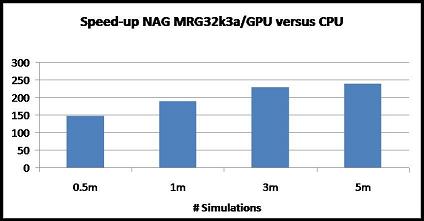Home > Press > More GPU Routines for Nanotech Research Now Available from Numerical Algorithms Group
 |
Abstract:
Scientists and engineers doing nanoscale modeling who are interested in achieving top performance from GPUs in diverse applications using Monte Carlo simulations can now obtain an updated version of NAG numeric routines for GPUs from the Numerical Algorithms Group (NAG).
More GPU Routines for Nanotech Research Now Available from Numerical Algorithms Group
Oxford, UK | Posted on May 4th, 2010General Purpose GPUs (graphical processing units) were originally used for 3D gaming acceleration on personal computers but have recently been at the forefront of numerical and scientific computation. Monte Carlo simulations are used in a wide array of technical computing applications in diverse areas such as finance, engineering simulations, drug discovery, scientific research, oil and gas exploration, and more.
Speaking for NVIDIA, a leader in GPU computing, Andrew Cresci, GM Vertical Marketing comments, "The ecosystem around GPU computing is growing rapidly and NAG's additions to their routines for GPU computing could not be more timely. NAG's numerical libraries are renowned for delivering top performance while maintaining the highest standards of accuracy. There are now some 60,000 active CUDA developers, and providing access to trusted algorithms from NAG is a major milestone that enhances the maturity of NVIDIA's GPU computing architecture."
NAG's numerical routines for GPU computing are available to academic researchers involved in collaborative research with the NAG organization. Commercial organizations can also get access to NAG's GPU code and programming services by contacting the NAG offices in their locale -- www.nag.com/contact_us.asp.
The latest release of NAG's code for GPUs contains routines for Monte Carlo simulations—Quasi and Pseudo Random Number Generators, Brownian bridge, and associated statistical distributions. For more details, see www.nag.com/numeric/GPUs.
####
About Numerical Algorithms Group
With origins in several UK universities, the Numerical Algorithms Group (NAG, www.nag.com), is an Oxford, UK headquartered not-for-profit numerical software development organization that collaborates with world-leading researchers and practitioners in academia and industry. NAG serves its customers from offices in Oxford, Manchester, Chicago, Tokyo and Taipei, through field sales staff in France and Germany, as well as via a global network of distributors.
Visit www.nag.com, www.nag.co.uk, www.nag-gc.com, and www.nag-j.co.jp
For more information, please click here
Contacts:
For editorial inquiries, please contact:
Amy Munice, ALM Communications, +1-773-862-6800, (skype) ALMCommunications.
Katie O’Hare, NAG Marketing Communications Manager, +44 (0)1865 511245.
Hiro Chiba, Chief Operating Officer – Nihon NAG,
+81 3 5542 6311.
Edward Chou, NAG Greater China General Manager, Tel: +886-2-2509328
Copyright © Numerical Algorithms Group
If you have a comment, please Contact us.Issuers of news releases, not 7th Wave, Inc. or Nanotechnology Now, are solely responsible for the accuracy of the content.
| Related News Press |
News and information
![]() Researchers develop molecular qubits that communicate at telecom frequencies October 3rd, 2025
Researchers develop molecular qubits that communicate at telecom frequencies October 3rd, 2025
![]() Next-generation quantum communication October 3rd, 2025
Next-generation quantum communication October 3rd, 2025
![]() "Nanoreactor" cage uses visible light for catalytic and ultra-selective cross-cycloadditions October 3rd, 2025
"Nanoreactor" cage uses visible light for catalytic and ultra-selective cross-cycloadditions October 3rd, 2025
Software
![]() Visualizing nanoscale structures in real time: Open-source software enables researchers to see materials in 3D while they're still on the electron microscope August 19th, 2022
Visualizing nanoscale structures in real time: Open-source software enables researchers to see materials in 3D while they're still on the electron microscope August 19th, 2022
![]() Luisier wins SNSF Advanced Grant to develop simulation tools for nanoscale devices July 8th, 2022
Luisier wins SNSF Advanced Grant to develop simulation tools for nanoscale devices July 8th, 2022
![]() Oxford Instruments’ Atomfab® system is production-qualified at a market-leading GaN power electronics device manufacturer December 17th, 2021
Oxford Instruments’ Atomfab® system is production-qualified at a market-leading GaN power electronics device manufacturer December 17th, 2021
Announcements
![]() Rice membrane extracts lithium from brines with greater speed, less waste October 3rd, 2025
Rice membrane extracts lithium from brines with greater speed, less waste October 3rd, 2025
![]() Researchers develop molecular qubits that communicate at telecom frequencies October 3rd, 2025
Researchers develop molecular qubits that communicate at telecom frequencies October 3rd, 2025
![]() Next-generation quantum communication October 3rd, 2025
Next-generation quantum communication October 3rd, 2025
![]() "Nanoreactor" cage uses visible light for catalytic and ultra-selective cross-cycloadditions October 3rd, 2025
"Nanoreactor" cage uses visible light for catalytic and ultra-selective cross-cycloadditions October 3rd, 2025
Tools
![]() Japan launches fully domestically produced quantum computer: Expo visitors to experience quantum computing firsthand August 8th, 2025
Japan launches fully domestically produced quantum computer: Expo visitors to experience quantum computing firsthand August 8th, 2025
![]() Rice researchers harness gravity to create low-cost device for rapid cell analysis February 28th, 2025
Rice researchers harness gravity to create low-cost device for rapid cell analysis February 28th, 2025
|
|
||
|
|
||
| The latest news from around the world, FREE | ||
|
|
||
|
|
||
| Premium Products | ||
|
|
||
|
Only the news you want to read!
Learn More |
||
|
|
||
|
Full-service, expert consulting
Learn More |
||
|
|
||








